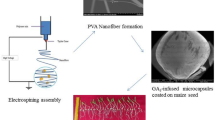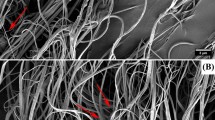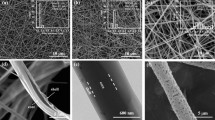Abstract
In the present study, nanofibers were developed from biodegradable polymer polyvinyl alcohol (PVA). PVA at 10% has produced fiber with required size (111 nm to 176 nm). The nanofiber was infused with plant growth promoting hormones, gibberellic acid (GA3) and indole acetic acid (IAA) and was characterized using SEM and UV–Vis spectroscopy. Topography of hormones-loaded electrospun fiber revealed that the diameter of the fiber was increased due to loading of hormones. GA3-loaded nanofibers had the diameter ranges from 131 to 296 nm, and IAA-loaded fibers had the diameter size ranges from 106 to 275 nm after loading. The UV–Vis spectra confirmed the hormonal loading in e-spun nanofiber. Hormones-infused PVA nanofibers were evaluated for its bio-efficacy on seed quality under in vitro condition, and the results revealed that IAA incorporated nano-fiber-coated seeds such as groundnut and black gram had registered higher germination at 88% and 86%, seedling vigor at 3458 and 3431, respectively. The nano-fibers-coated seeds were also tested under different PEG-induced moisture regimes. The data indicated that groundnut and black gram seeds coated with IAA-infused nanofibers were found to be registered higher germination and seedling vigor under higher moisture stress.



Similar content being viewed by others
References
Susan John S, Bharathi A, Natesan P, Raja K (2005) Effect of polymer coating on germination and seedling vigour in maize cv. Co 1. Karnataka J Agric Sci 18:343–348
Raja K, Sathish S (2017) Seed treatments for vigorous seedling establishment and improved seed yield of blackgram under rice fallow condition. Legume Res 41:120–125
Raja K, Karivaradaraaju TV, Ponnuswamy AS, Thavaprakash N (2004) Influence of seed treatment on bruchid control in greengram Cv. CO 6 under ambient storage condition. Legume Res Int J 27:286–289
Raja K, Karthikeyan M, Johnson I, Latha P, Saravanakumar D (2017) Antagonistic ACC deaminase producing Pseudomonas fluorescens with polymer seed coating for the management of rice fallow black gram diseases. Adv Res 10:1–12
Duraimurugan P, Raja K, Regupathy A (2011) An eco-friendly approach for management of pulse beetle, Callosobruchus maculatus through neem formulations assisted with pitfall trap. J Food Legumes 24:23–27
Bharathi A, Palanisamy V, Raja K, Natesan P, Krishnasamy V, Vanangamudi K (2007) Seed development, maturation and germination improvement in gaillardia. Madras Agric J 94:183
Murata MR, Zharare GE, Hammes PS (2008) Pelleting or priming seed with calcium improves groundnut seedling survival in acid soils. J Plant Nutr 31:1736–1745
Dileep Kumar G, Raja K, Natarajan N, Govindaraju K, Subramanian KS (2020) Invigouration treatment of metal and metal oxide nanoparticles for improving the seed quality of aged chilli seeds (Capsicumannum L.). Mater Chem Phy 242:122492
Raja K, Sowmya R, Sudhagar R, Moorthy PS, Govindaraju K, Subramanian KS (2019) Biogenic ZnO and Cu nanoparticles to improve seed germination quality in blackgram (Vigna mungo). Mater Lett 235:164–167
Prerna DI, Govindaraju K, Tamilselvan S, Kannan M, Raja SKS (2019) Seaweed-based biogenic ZnO nanoparticles for improving agro-morphological characteristics of rice (Oryza sativa L.). J Plant Growth Regul 39:717–728
Yang FL, Li XG, Zhu F, Lei CL (2009) Structural characterization of nanoparticles loaded with garlic essential oil and their insecticidal activity against Tribolium castaneum (Herbst) (Coleoptera: Tenebrionidae). J Agric Food Chem 57:10156–10162
Leticia CMF, Genro C, Roggia I, Bender SS, Bender RJ, Pereira CN (2014) Innovative rice seed coating (Oryza Sativa) with polymer nanofibres and microparticles using the electrospinning method. J Res Updat Polym Sci 3:33–39
Krishnamoorthy V, Elumalai G, Rajiv S (2016) Environment friendly synthesis of polyvinylpyrrolidone nanofibers and their potential use as seed coats. New J Chem 40:3268–3276
Damasceno R, Roggia I, Pereira C, de Sa E (2013) Rhizobia survival in seeds coated with polyvinyl alcohol (PVA) electrospun nanofibres. Can J Microbiol 59:716–719
Veras FF, Roggia I, Pranke P, Pereira CN, Brandelli A (2016) Inhibition of filamentous fungi by ketoconazole-functionalized electrospun nanofibers. Eur J Pharm Sci 84:70–76
Castaneda LMF, Genro C, Roggia I, Bender SS, Bender RJ, Pereira CN (2014) Innovative rice seed coating (Oryza sativa) with polymer nanofibres and microparticles using the electrospinning method. J Res Updat Polym Sci 3:33–39
Latha M, Raja K, Subramanian KS, Karthikeyan M, Lakshmanan A (2019) Fabrication and characterization of tebuconazole loaded PVA nanofibre. Int J Agric Sci 10:8514–8517
ISTA (2013) International rules for seed testing. The International Seed Testing Association, Basssersdorf, Switzerland
Abdul-Baki AA, Anderson JD (1973) Vigor determination of soybean seed by multiple criteria. Crop Sci 13:630–633
Muscolo A, Sidari M, Anastasi U, Santonoceto C, Maggio A (2014) Effect of PEG-induced drought stress on germination of four lentil genotypes. J Plant Interact 9:354–363
Panse VG, Sukhatme PV (1967) Statistical methods agricultural workers. Indian Council of Agricultural Research (ICAR), New Delhi
Deitzel JM, Kleinmeyer J, Harris D, Beck Tan NC (2001) The effect of processing variables on the morphology of electrospun nanofibers and textiles. Polymer 42:261–272
Lee KH, Kim HY, Bang HJ, Jung YH, Lee SG (2003) The change of bead morphology formed on electrospun polystyrene fibers. Polymer 44:4029–4034
Yu JH, Fridrikh S, Rutledge GC (2006) The role of elasticity in the formation of electrospun fibers. Polymer 47:4789–4797
Semnani K, Shams-Ghahfarokhi M, Afrashi M, Fakhrali A, Semnani D (2018) Antifungal activity of eugenol loaded electrospun PAN nanofiber mats against Candida albicans. Curr Drug Deliv 15:860–866
Clayton PB (1988) Seed treatment technology—the challenge ahead for the agricultural chemicals industry. Br Crop Prot Counc Monogr 39:247
Henderson JC, Hensley L (1987) Effect of a hydrophilic gel on seed germination of three tree species. Hort Sci 22:450–452
Richard L, Young JD, Min DH (2003) Coated alfalfa seed, is it worth it. Forage information systems, Michigan State University. https://forage.msu.edu/extension/coated-alfalfa-seed-is-it-worth-it/
Waycott W, Taiz L (1991) Phenotypic characterization of lettuce dwarf mutants and their response to applied gibberellins. Plant Physiol 95:1162–1168
Saeed Moori and Hamid Reza Eisvand (2017) Plant growth regulators and ascorbic acid effects on physiological quality of wheat seedlings obtained from deteriorated seeds. Pak J Bot 49(5):1811–1819
Tamilarasan C, Raja K, Subramanian KS, Selvaraju P (2019) Synthesis and development of nano formulation for hastening seed quality in groundnut. Res J Agric Sci 10:50–57
Acknowledgements
The author KR gratefully acknowledged to Department of Science and Technology, Ministry of Science and Technology, Government of India, New Delhi, for financial assistance. The authors thank Tamil Nadu Agricultural University (TNAU), Coimbatore, for support in research activities.
Funding
Funding was provided by Department of Science and Technology (DST), Government of India (IN) (CRG/2019/002871 Dated 11.02.2020).
Author information
Authors and Affiliations
Corresponding author
Additional information
Publisher's Note
Springer Nature remains neutral with regard to jurisdictional claims in published maps and institutional affiliations.
Rights and permissions
About this article
Cite this article
Raja, K., Prabhu, C., Subramanian, K.S. et al. Electrospun polyvinyl alcohol (PVA) nanofibers as carriers for hormones (IAA and GA3) delivery in seed invigoration for enhancing germination and seedling vigor of agricultural crops (groundnut and black gram). Polym. Bull. 78, 6429–6440 (2021). https://doi.org/10.1007/s00289-020-03435-6
Received:
Revised:
Accepted:
Published:
Issue Date:
DOI: https://doi.org/10.1007/s00289-020-03435-6




